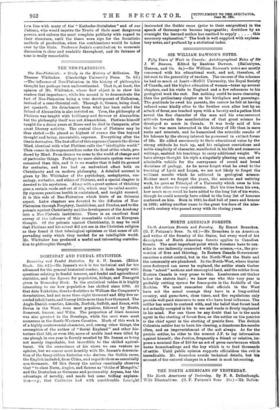DOMESDAY AND FEUDAL STATISTICS.
Doniesday and Feudal Statistics. By A. IT. Inman. (Elliot Stock. 10s. 61.)—Mr. lumen's work is too technical and far too advanced for the general historical reader; it deals largely with questions relating to feudal tenures, and feudal and agricultural statistics, and the figures for population, hidage, and Danegeld given in Domesday Book. In the statistical tables it is highly interesting to see how populatien has shifted since 1086. At that date Yorkshire, thanks doubtless to William the Conqueror's devastations, had not more than eight thousand and fifty-five re- corded inhabitants, and Surrey little more than four thousand. The Anglo-Danish counties, Lincoln, Norfolk, Suffolk, and Essex, with Devon in the West, were most populous, followed by Hants, Somerset, Sussex, and Wilts. The proportion of liberi homines was also greatest in the Danelaga, while the servi were most numerous in the South-Western Counties. Much of this work is of a highly controversial character, and, among other things, the assumption of the author of "Social England" and other his- torians that 120, or even 180, acres of arable land were tilled by one plough in one year is fiercely assailed by Mr. Inman as being not merely improbable, but incredible to the skilled agricul- turist. On the correctness of his views we can venture no opinion, but we concur most heartily with Mr. Incaan's denuncia- tion of the fancy-ridden historian who derives the Gothic races, the English included, from China, and regards them as essentially non-Germanic. Of this theory the author caustically observes that "to class Norse, Angles, and Saxons as 'Goths of Mongolia,' and the Deutschen as Germans and presumably Aryans, has the advantage of novelty, and needs but some trifling explana- tion—e.g., that Confucius had with considerable foresight
instructed the Gothic races (prior to their emigration) in the speech of Germany—to become impregnable; doubtless by an oversight the learned author has omitted to supply this necessary explanation." The book is well supplied with explana- tory notes, and prefaced by a statistical index.




















































 Previous page
Previous page